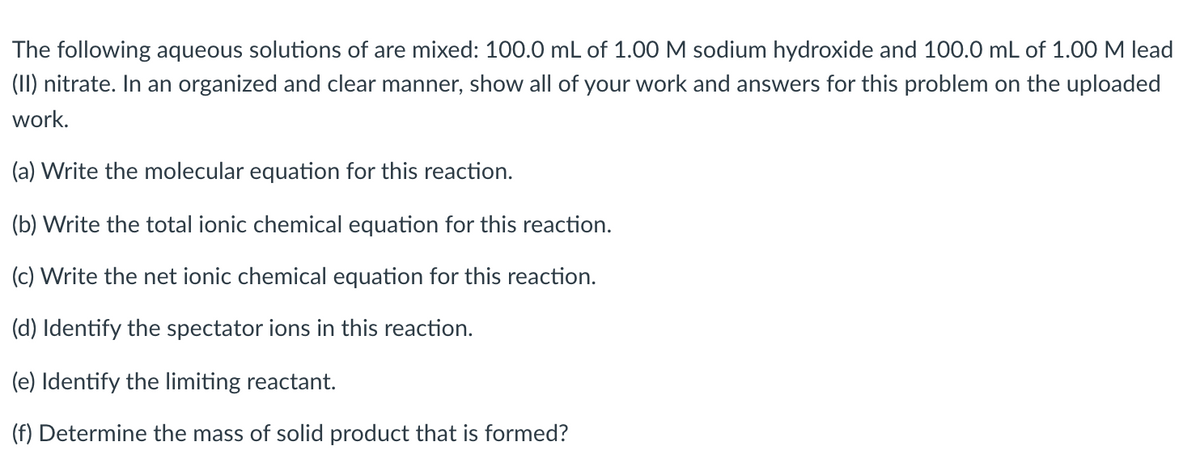The following aqueous solutions of are mixed: 100.0 mL of 1.00 M sodium hydroxide and 100.0 mL of 1.00 M lead (II) nitrate. In an organized and clear manner, show all of your work and answers for this problem on the uploaded work. (a) Write the molecular equation for this reaction. (b) Write the total ionic chemical equation for this reaction. (c) Write the net ionic chemical equation for this reaction. (d) Identify the spectator ions in this reaction. (e) Identify the limiting reactant. (f) Determine the mass of solid product that is formed?
The following aqueous solutions of are mixed: 100.0 mL of 1.00 M sodium hydroxide and 100.0 mL of 1.00 M lead (II) nitrate. In an organized and clear manner, show all of your work and answers for this problem on the uploaded work. (a) Write the molecular equation for this reaction. (b) Write the total ionic chemical equation for this reaction. (c) Write the net ionic chemical equation for this reaction. (d) Identify the spectator ions in this reaction. (e) Identify the limiting reactant. (f) Determine the mass of solid product that is formed?
Introductory Chemistry: A Foundation
9th Edition
ISBN:9781337399425
Author:Steven S. Zumdahl, Donald J. DeCoste
Publisher:Steven S. Zumdahl, Donald J. DeCoste
Chapter7: Reactions In Aqueous Solutions
Section: Chapter Questions
Problem 82AP: Which of the following statements is/are true regarding solutions? l type='a'> If a solute is...
Related questions
Question

Transcribed Image Text:The following aqueous solutions of are mixed: 100.0 mL of 1.00 M sodium hydroxide and 100.0 mL of 1.00 M lead
(II) nitrate. In an organized and clear manner, show all of your work and answers for this problem on the uploaded
work.
(a) Write the molecular equation for this reaction.
(b) Write the total ionic chemical equation for this reaction.
(c) Write the net ionic chemical equation for this reaction.
(d) Identify the spectator ions in this reaction.
(e) Identify the limiting reactant.
(f) Determine the mass of solid product that is formed?
Expert Solution
This question has been solved!
Explore an expertly crafted, step-by-step solution for a thorough understanding of key concepts.
This is a popular solution!
Trending now
This is a popular solution!
Step by step
Solved in 2 steps

Knowledge Booster
Learn more about
Need a deep-dive on the concept behind this application? Look no further. Learn more about this topic, chemistry and related others by exploring similar questions and additional content below.Recommended textbooks for you

Introductory Chemistry: A Foundation
Chemistry
ISBN:
9781337399425
Author:
Steven S. Zumdahl, Donald J. DeCoste
Publisher:
Cengage Learning

Chemistry: The Molecular Science
Chemistry
ISBN:
9781285199047
Author:
John W. Moore, Conrad L. Stanitski
Publisher:
Cengage Learning

Chemistry by OpenStax (2015-05-04)
Chemistry
ISBN:
9781938168390
Author:
Klaus Theopold, Richard H Langley, Paul Flowers, William R. Robinson, Mark Blaser
Publisher:
OpenStax

Introductory Chemistry: A Foundation
Chemistry
ISBN:
9781337399425
Author:
Steven S. Zumdahl, Donald J. DeCoste
Publisher:
Cengage Learning

Chemistry: The Molecular Science
Chemistry
ISBN:
9781285199047
Author:
John W. Moore, Conrad L. Stanitski
Publisher:
Cengage Learning

Chemistry by OpenStax (2015-05-04)
Chemistry
ISBN:
9781938168390
Author:
Klaus Theopold, Richard H Langley, Paul Flowers, William R. Robinson, Mark Blaser
Publisher:
OpenStax

Chemistry: An Atoms First Approach
Chemistry
ISBN:
9781305079243
Author:
Steven S. Zumdahl, Susan A. Zumdahl
Publisher:
Cengage Learning

Chemistry
Chemistry
ISBN:
9781305957404
Author:
Steven S. Zumdahl, Susan A. Zumdahl, Donald J. DeCoste
Publisher:
Cengage Learning
